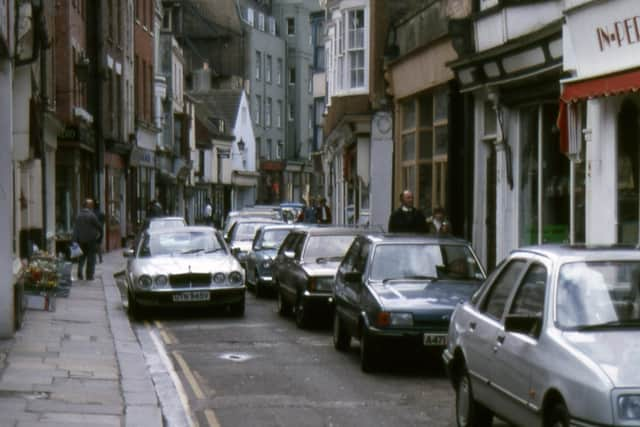Exploring the fascinating history of a much loved Hastings Old Town street
and live on Freeview channel 276
Here, local historian Steve Peak remembers when it was busy with vehicles and traffic.
He said: “When Hastings Council in the early 1980s proposed turning the one-way through-road of George Street into a car-free pedestrian zone, there was widespread opposition from many shopkeepers, fearing that “no cars” meant “no customers”. But today, pedestrianised George Street is the highly popular heart of the Old Town, with many busy cafes, restaurants and fashion shops.
Advertisement
Hide AdAdvertisement
Hide Ad“Most of the buildings on the street look much the same now as when it was closed to traffic on 19 October 1986, but many have very different occupants.


Have you read? People share memories of homeless man Billy Pole who Hastings took to its heart in thre 1980’s
“Near the east end, what are now the Clockwork Crow and Warp & Weft stores were then an ironmongers, called Len Butler’s Emporium, full of handy DIY things (and the very helpful Len in a brown frock-coat). Next door is the hairdressers Hair to Stay, which was the Spastics Shop in 1986, although for many decades before then it had been Stricklands, the leading agricultural merchant in Hastings.
“Next along is the fancy goods shop Flibbertigibbet, which was Lloyds Bank in 1986, and further still is fashion specialist Voodoo Sirens, then Cable’s Pram Stores.
Advertisement
Hide AdAdvertisement
Hide Ad“A landmark in today’s George Street is the open-air community space Butler’s Gap. Until 1976 this had been the big four-storey warehouse of TW Barnes, the scrap dealers. But on 23 July that year it was ravaged by a major fire, and 60 firefighters with ten fire engines fought the blaze to stop it spreading to nearby properties. The street was closed to traffic for three months while preparations were made to demolish the building. The site was converted into Butler’s Gap in mid-1995.
“A notable building in the street is the green-painted former pawnbrokers and Jewellers of HB Wright, on the corner with Russell Court. It had been started in 1860 by Edwin Bradnam, Mayor of Hastings three times, and a well-respected local figure. It closed in March 1975 and its frontage has remained unchanged since then.
“The closure of the post office at 20 George Street in January 1985 was seen by Hastings Council as part of an inevitable continuing decline of the street, and so they pressed ahead with transforming it. The new pedestrianised George Street was officially opened by film star Bernard Bresslaw on 25 April 1987. Until the late 18th century, George Street was known as the Suburb, as it lay outside the town wall built across the mouth of the Bourne Valley after the French raids of the 14th century.
“Initially the Suburb was just a road going along the coast to the west, but as Hastings began expanding in the 17th century, development took place along it.
Advertisement
Hide AdAdvertisement
Hide Ad“By the 1780s Hastings had become a popular seaside resort, and the streets and pavements of the town were urgently in need of some control and maintenance. So in 1789 the Hastings Improvement Act was given assent by King George III, and the Suburb was named after him as George Street.
“But the Act only covered the parish of St Clements, which was where most of the town’s better-off residents lived. The east boundary of the parish was the Bourne Stream, and the west was only as far along George Street as Russell Court. However by 1820 the increasing problems with the management of the town outside the parish forced the local establishment to obtain another Improvement Act covering All Saints (and the fishermen) to the east and St Mary in the Castle to the west.
“The west end of the street is Sturdee Place, the former Hastings Coastguard headquarters built in 1904. It stands on the site of an old military emplacement, probably built in the 17th century.”
Have you read? Photo of a huge shark taken by a Hastings man goes viral